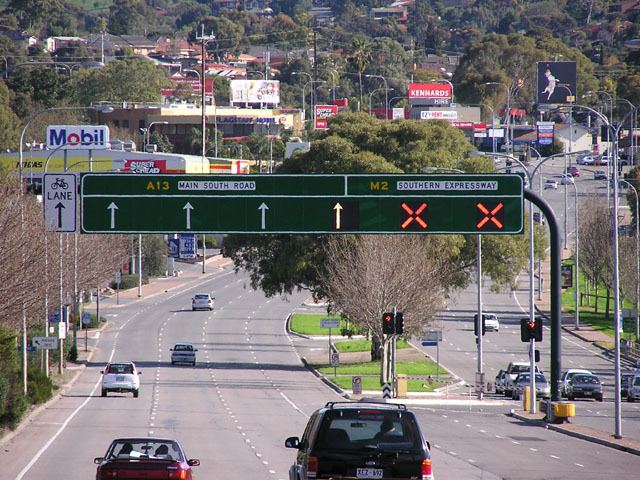Type Road | Length 115 km | |
 | ||
Route number(s) A13
(Wingfield - Old Noarlunga)
B23
(Old Noarlunga - Cape Jervis) North end Salisbury Highway
Port River Expressway, Wingfield, Adelaide South end Cape Jervis-Noarlunga Road, Cape Jervis, South Australia
via Ferry to Kangaroo Island Major suburbs Croydon, Hindmarsh, Mile End, Reynella, Morphett Vale, Old Noarlunga, Aldinga, Sellicks Hill, Yankalilla Major cities Morphett Vale, Aldinga, Old Noarlunga, Yankalilla, South Australia Via Croydon, South Australia, Hindmarsh, Mile End, Reynella | ||
Main south road adelaide south australia
South Road (route A13, B23) is a major north–south conduit in Adelaide and Fleurieu Peninsula in South Australia. Also known as Main South Road, it is one of Adelaide's most important arterial and bypass roads.
Contents
- Main south road adelaide south australia
- Map of South Rd South Australia Australia
- History
- Route
- Congestion and upgrades
- References
Map of South Rd, South Australia, Australia
History
South Road of today was until the 1970s known by a string of names: Shillabeer Avenue (north of Torrens Road), Government Road (between Torrens and Port Roads), John Street (Port to Grange Roads), Taylors Road. (between Grange and Henley Beach Roads), Fisher Terrace (Henley Beach Road to Anzac Highway), and South Road from Anzac Highway southwards.
Route
South Road carries much of the road traffic from the southern suburbs towards the Adelaide city centre. This traffic completes its journey to the city centre mainly via the Anzac Highway.
From the Anzac Highway, South Road continues north as a western bypass of the city across many arterials, the major ones being Sir Donald Bradman Drive, Port Road, Torrens Road, Regency Road and Grand Junction Road, to the junction with the Port River Expressway and the Salisbury Highway. Until the Port River Expressway opened in 2005, the sections of South Road and Salisbury Highway between Grand Junction Road and Port Wakefield Road were known as the South Road Extension, built in the early 1990s.
To the south of Anzac Highway, the name changes to Main South Road at the intersection of Ayliffes and Shepherds Hill Roads at Clovelly Park, and continues through Seaford (where the Victor Harbor road branches off) and runs parallel to the coastline of Gulf St Vincent until Normanville where it is known as Willis Drive for 2 km then continues to Cape Jervis at its southern tip. The town of Old Noarlunga, South Australia was bypassed in 1972, and Old Reynella in 1964. The Southern Expressway (M2) runs roughly parallel to Main South Road for 18 km between Darlington and Noarlunga and serves to reduce traffic congestion. Main South Road and the Southern Expressway have 3 different intersections along the length of the roads.
Congestion and upgrades
South Road suffers from traffic congestion due to its importance as one of Adelaide's main arterial roads and bypasses. Traffic has also increased in line with the growth and development of Adelaide's southern suburbs.
An overpass was built over Cross Road and the Noarlunga railway line between 1982 and 1984 to reduce a major bottleneck.
The State government completed the "Gallipoli Underpass" under Anzac Highway, and an overpass of the Adelaide-Glenelg tramway, in 2009 and 2010. The underpass model used is a diamond interchange.
In November 2005, the Royal Automobile Association (RAA) released its recommendations to the South Australian government in regards to the road network. South Road was found to be the poorest road in the state, registering a 2/10 on the RAA's scale. The recommendations given included $6 billion of funds to upgrade the roads of South Australia – with $1.5–2 billion to be spent on South Road alone. The RAA's plan for the road included a 6 km tunnel from Port Road all the way to the Anzac Highway underpass and over/underpasses at six other major intersections and two rail crossings.
On 18 August 2007, Prime Minister John Howard announced that South Road was to be included in the AusLink National Road Network, and also pledged $1 billion in funding for the project between 2007 and 2020.
In October 2009, both the Premier of South Australia and the Prime Minister released plans for the South Road Superway- a 3–4 km section of elevated freeway running from the Port River Expressway to the intersection of Regency Road at a cost of $800 million. The project started in 2010 and was completed in early 2014. The elevated part provides separation at Grand Junction Road, Cormack Road, and the Dry Creek-Port Adelaide railway line.
Two further sections were identified and funded for upgrade following the 2013 Australian federal election. The first of these was the Darlington Upgrade addressing the section from the northern end of the Southern Expressway to provide a free-flowing route under the intersections with Flinders Drive and Sturt Road to the Ayliffes Road intersection. The Torrens Road to River Torrens project addresses the major intersections with Grange and Port Roads, the Outer Harbor railway line crossing, and several minor road intersections. Both of these upgrades involve land acquisition to widen the road corridor, surface grade carriage ways on the edges, and a lowered central roadway carrying the free-flow traffic below the crossing routes. The Torrens to Torrens project was started in 2015, and is expected to be completed by the end of 2018.
In January 2017, the Outer Harbor railway line level crossing was replaced in a grade separation project.
